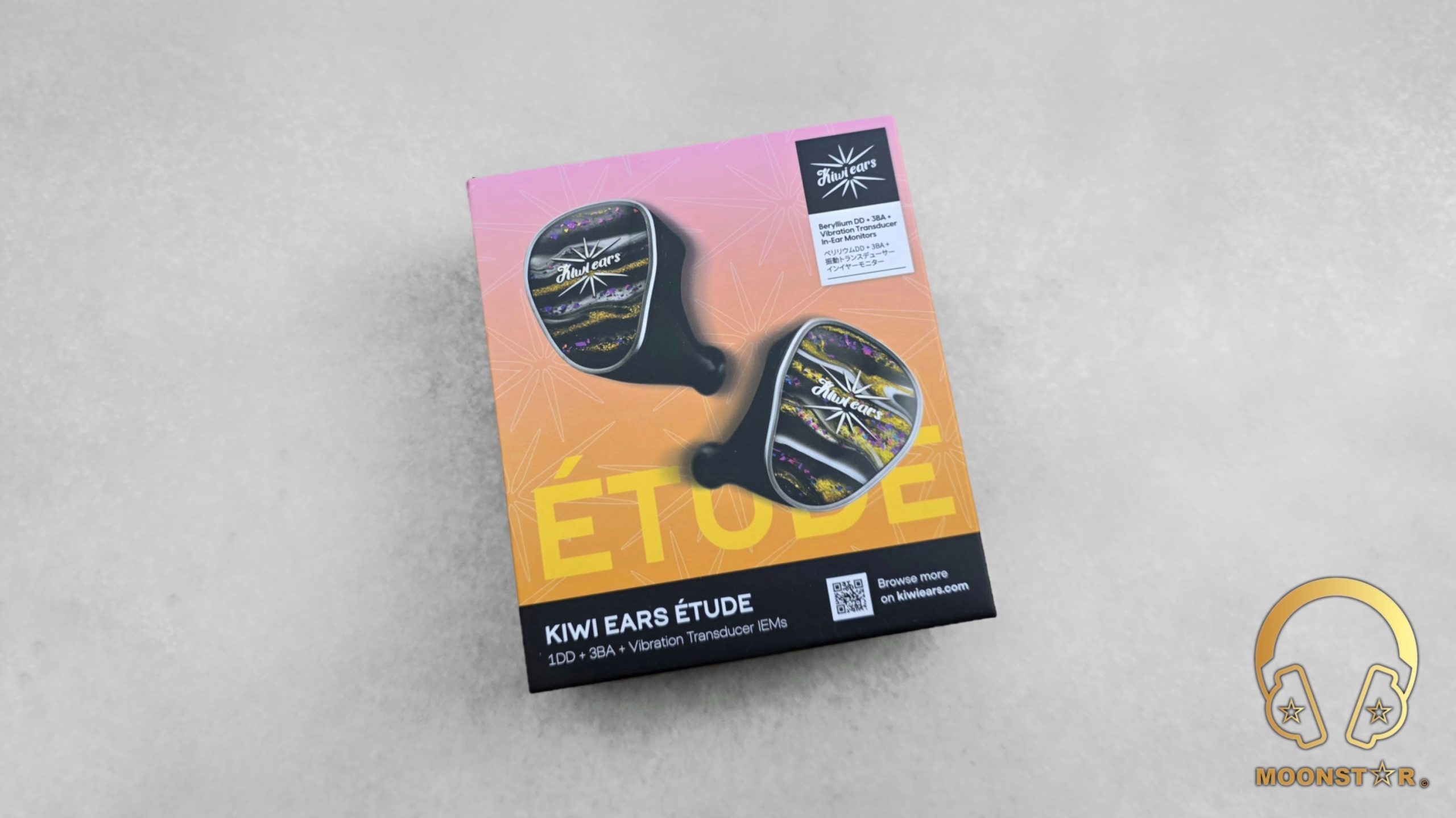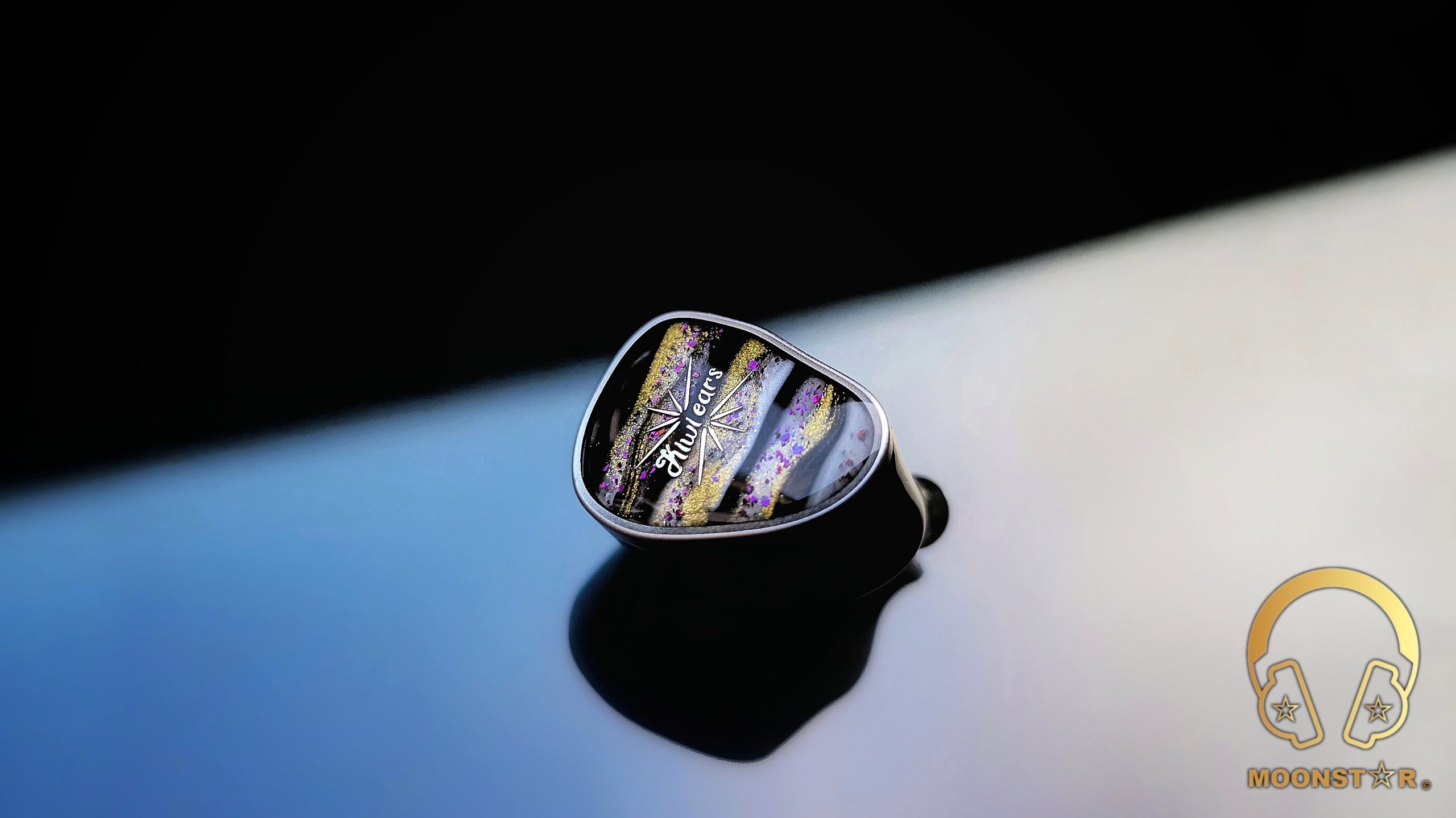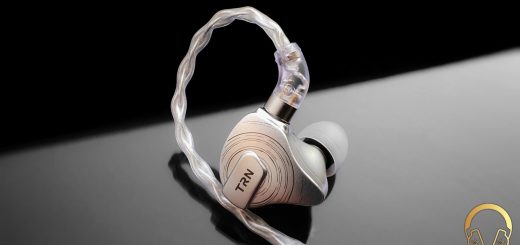Kiwi Ears Étude Review

Kiwi Ears Étude Review
Introduction:
The Kiwi Ears Étude is an in-ear monitor featuring a unique driver configuration. Each earpiece incorporates a five-driver setup, consisting of a proprietary Kiwi Vibration Transducer (KVT), a 10mm Beryllium diaphragm dynamic driver, and three Custom Balanced Armature drivers. These components are housed within semi-custom, medical-grade resin shells, complemented by a lemon-yellow faceplate. Connectivity is facilitated by detachable 0.78mm 2-pin connectors, positioned on the top of the earpieces.
In this review, I’ll explore the features and performance of the Kiwi Ears Étude in a straightforward manner, sharing my personal impressions of this distinctive IEM.

Disclaimer:
I would like to thank Linsoul and Kiwi Ears for providing the Kiwi Ears Étude for review purposes. I am not affiliated with Linsoul or Kiwi Ears beyond this review and these words reflect my true and unaltered opinions about the product.
Price & Availability:
The Kiwi Ears Étude costs $119.00 USD, a solid value for its features.More informations can be found under the link below:
Package & Accessories:
The Kiwi Ears Étude comes in a compact box with a glossy yellow background, featuring the model’s image and the Kiwi Ears logo on the front. It’s eye-catching and feels premium for the price. The side lists specs, and the back includes the manufacturer’s details and certifications.


Inside the box are the following contents/accessories;
- 1 x pair of Kiwi Ears Étude In-Ear Monitors
- 1 x Detachable Cable with 2-Pin Connectors
- 9 x pairs of Silicone Ear Tips (1 pair came pre-installed)
- 1 x Zipper Case
- 1 x Print Material

The contents are neatly packed, and the soft-lined carrying case is practical. The ear tips provide plenty of fit options, but the package is a bit basic compared to pricier IEMs.

Design & Build Quality:
The Kiwi Ears Étude features a lightweight yet sturdy build with medical-grade resin shells. However, the main highlight is the handcrafted faceplate that really grabs attention with its vibrant lemon-yellow color. It has a glossy, semi-transparent finish that gives it a lively, dynamic appearance. I noticed tiny iridescent flecks embedded in the resin; they beautifully catch the light, creating a soft shimmer that subtly shifts between pale green and golden tones depending on how the light hits it. The surface feels incredibly smooth, with just a hint of tackiness that makes handling secure, and the rounded edges add a refined touch.

The Kiwi Ears logo, etched in clean silver at the center, keeps the design minimal yet elegant. Overall, this faceplate is quite eye-catching without being over the top, offering a great mix of personality and sophistication for anyone who appreciates a unique aesthetic.

The sound nozzle, located at the inner surface, is slightly short, which might affect the fit and isolation for some users. It lacks a metal mesh filter, relying on the resin’s smooth finish to keep debris out. Three separate bores inside channel sound from each driver, ensuring clarity and separation across frequencies. The nozzle’s width supports a good seal with most tips.

The monitor shells feature 0.78mm 2-pin female connectors located on top, ensuring a tight and secure connection. Also on the top are two small openings dedicated to pressure relief.

Another pressure relief opening is situated on the rear surface.

The Kiwi Ears Étude includes a detachable, lightweight, twisted cable. While the exact material isn’t specified, it’s likely OFC (Oxygen-Free Copper), consistent with other Kiwi Ears models.

The cable’s 0.78mm 2-pin male connectors are protected by a black metal housing, with the right connector featuring a red indicator and the left being transparent.

The cable terminates in a 3.5mm headphone plug, safeguarded by a straight metal housing and a transparent plastic strain relief for enhanced durability.

Fit, Comfort & Isolation:
The Kiwi Ears Étude’s shells fit well in medium to large ears, but smaller ears might find them bulky. The smooth shape ensures comfort for long sessions, and the ear tips help achieve a good seal, crucial for bass and isolation. The short nozzle can reduce isolation slightly, letting some noise leak in places like cafes or trains. It’s still a solid pick for commuting.

Technical Specifications:
- Model: Étude
- Driver Technology: 1 x Kiwi Vibration Transducer (KVT), 1 x 10mm Beryllium Diaphragm Dynamic Driver, 3 x Custom Balanced Armature Drivers
- Frequency Response: 20Hz–20kHz
- Sensitivity: 104dB SPL/mW
- Impedance: 5Ω
- Connector Type: 0.78mm 2-Pin Connector
- Plug: 3.5mm Single-Ended
- Cable Material: High-Purity Oxygen-Free Copper (OFC), Braided
- Cable Length: 1.2 Meters
- Shell Material: Medical-Grade Resin
Drivability & Pairing:
Despite its relatively low 5Ω impedance and 104dB sensitivity, I found the Kiwi Ears Étude isn’t as effortlessly driven as those numbers might suggest. While USB DAC dongles certainly get sound out of it, to truly unlock the full potential of its bass control and intricate detail, especially from that unique Kiwi Vibration Transducer (KVT), I noticed it often demands more robust amplification.
I’d recommend a Digital Audio Player (DAP) like the FiiO JM21 or HiBy R3Pro II, or any source capable of delivering at least 2VRMS of power, to fully utilize the KVT and achieve the intended sonic experience. Pairing the Étude with a neutral or warm source tends to highlight its impactful lows and lush mids beautifully. Conversely, I found that underpowered sources resulted in a flatter, less dynamic sound.
The Étude truly demonstrates excellent scaling with better gear. When I hooked it up to a more capable source, it revealed so much more texture, clarity, and those unique tactile vibrations from the KVT driver that make its bass truly distinctive. It’s clear that investing in a capable source can significantly enhance your listening pleasure with the Étude.

Equipment’s used for this review:
- IEM’s : Kiwi Ears Étude, Dunu Kima2
- DAP&DAC’s : FiiO JM21, HiBy R3Pro II
Albums & tracks used for this review:
- Norah Jones – Come Away With Me (Apple Music Lossless)
- Adele – My Little Love (Apple Music Lossless)
- Sarah McLachlan – Angel (Flac 24bit/48kHz)
- Sertap Erener – Aşk (Flac 16bit/44.1kHz)
- Edith Piaf – Non Je Ne Regrette Rien (Flac 16bit/44.1kHz)
- Diana Krall – So Wonderful (DSF)
- Aretha Franklin – I Say A Little Payer (Flac 24bit/96kHz)
- Michael Jackson – Billie Jean (Flac 24bit/96kHz)
- George Michael – Don’t Let the Sun Go Down on Me (Flac 24bit/192kHz)
- David Bowie – Heroes (Flac 24bit/192kHz)
- Elton John – Rocket Man ((Flac 24bit/96kHz)
- Barry White – Just The Way You Are (Flac 24bit/48kHz)
- Isaac Hayes – Walk On By (Flac 16bit/44.1kHz)
- Sting – Englishman in New York – (Flac 24bit/48kHz)
- Eric Clapton – Wonderful Tonight (Flac 24bit/96kHz)
- Dave Gahan – Kingdom (Tidal Hi-Fi)
- Radiohead – Live in Berlin “Album” (Apple Music Lossless)
- Radiohead – Pyramid Song (Apple Music Lossless)
- U2 – Sunday Bloody Sunday (Flac 16bit/44.1kHz)
- Muse – Hysteria (Flac 24bit/96kHz)
- Red Hot Chili Peppers – Nobody Weird Like Me (Flac 24bit/48kHz)
- Michael Jackson – Billie Jean (Flac 24bit/96kHz)
- Bear McCreary’s – Valkyries (Deezer HiFi)
- Bro Safari, UFO! – Drama (Deezer HiFi)
- Armin Van Buuren – Vini Vici (Flac 16bit/44.1kHz)
- Daft Punk – Instant Crush (Flac 24bit/96kHz)
- Daft Punk – Doin’ it Right (Flac 24bit/96kHz)
- Lorde – Royals (Flac 24bit/48kHz)
- Massive Attack – Angel (Flac 24bit/48kHz)
- Toutant – Rebirth (Deezer HiFi)
- Gogo Penguin – Raven (Flac 24bit/192kHz)
- Gogo Penguin – Murmuration (Flac 24bit/192kHz)
- Portishead – It Could Be Sweet (Apple Music Lossless)
- Hans Zimmer – The Dark Knight OST (Flac 24bit/96kHz)
- Max Richter – On the Nature of Daylight (Flac 24bit/96kHz)
- Charly Antolini – Duwadjuwandadu (Flac 24bit/192kHz)
- Tchaikovsky – Symphony No. 5 (Flac 16bit/44.1kHz)
- Ferit Odman – Look, Stop & Listen (Flac 24bit/192kHz)
- Chopin – Nocturn No. 20 In C-Sharp Minor (Flac 16bit/44.1kHz)
- Clair de Lune – Claude Debussy (Spotify)
- Fazıl Say – Nazım Oratoryosu (Live) (Flac 16bit/44.1kHz)
- Vivaldi – Le QuarttroStagioni “The Four Season” (Apple Music Lossless)
- Pink Floyd – Shine On You Crazy Diamond (Apple Music Lossless)
- Miles Davis – So What (Deezer HiFi)
- Otto Liebert& Luna Negra – The River (Flac 24bit/192kHz)
- Lunatic Soul – The Passage (Flac 16bit/44.1kHz)
- Deftones – My Own Summer (Shove it) (Flac 16bit/44.1kHz)
- Metallica – Dyers Eve (Flac 24bit/96kHz)
- Metallica – Sad but True (Flac 24bit/96kHz)
- Opeth – Windowpane (Flac 16bit/44.1kHz)
- Megadeth – Sweating Bullets (Tidal Hi-Fi)
- Rush’s – Tom Sawyer (Flac 16bit/44.1kHz)
- Slayer – Angel of Death (Spotify)
- Liquid Tension Experiment 2 – Acid Rain (Spotify)
- Yosi Horikawa – Bubbles (Spotify)

The Sound:
The Kiwi Ears Étude delivers a lively, mild U-shaped sound signature with a focus on tactile bass, natural mids, and smooth treble, making it a versatile pick for genres like jazz, pop, rock, and progressive metal. The Kiwi Vibration Transducer (KVT) and 10mm beryllium dynamic driver bring a unique, physical low-end presence, while the three custom balanced armature drivers ensure clear vocals and refined highs. Its soundstage is spacious for its price, with precise imaging that handles complex tracks with ease. These impressions come after a 60-hour burn-in using the stock cable and black silicone tips, paired with the FiiO JM21 and HiBy R3Pro II. The Étude offers a relaxed, musical vibe, perfect for casual listening, though it may fall short for those seeking deep subbass or hyper-detailed treble.

Bass:
The Étude’s bass is engaging and tactile, driven by the KVT and beryllium dynamic driver, with a focus on midbass punch over deep subbass rumble. In Michael Jackson’s “Billie Jean,” the kick drums and bass guitar lines hit with a thick, energetic snap, delivering a fun, groovy feel that makes pop tracks come alive. The KVT adds a unique, almost physical texture to the bass, making each note feel vibrant and present. However, in Lorde’s “Royals,” the subbass lacks the deep, guttural extension some might crave, offering a warm but slightly restrained rumble that doesn’t quite shake the floor.
Bass guitars in “Billie Jean” are clear and well-separated from drums, showing good texture for the price, but the attack can feel a touch soft in fast-paced tracks like Gogo Penguin’s “Raven,” where complex bass passages demand tighter control. The bass is clean, avoiding muddiness, and its speed keeps up with most genres, from rock to jazz. While not basshead-level, it’s a musical, controlled low-end that gets the job done for casual listeners, though electronic fans might wish for more subbass heft.

Midrange:
The midrange of the Kiwi Ears Étude offers a pretty warm, natural, and vocal-centric presentation that excels with both male and female voices. In Adele’s “My Little Love,” her vocals are rich and emotive, with a smooth, transparent quality that captures every nuance in the midrange, making it feel intimate and heartfelt. Lower mids shine in Eric Clapton’s “Wonderful Tonight,” where his voice carries a full-bodied, slightly husky tone that feels like a cozy conversation. David Bowie’s “Heroes” highlights the midrange’s ability to handle male vocals with clarity and warmth, while Diana Krall’s “So Wonderful” brings out upper midrange finesse, with her voice sounding crisp yet smooth, free of harshness. Acoustic guitars in Clapton’s track have a natural, woody timbre, and pianos in Krall’s piece carry a soft, organic resonance.
The KVT can add a subtle metallic tinge to instruments like electric guitars in Bowie’s track, but it’s not distracting and gives the Étude a unique character. The midrange’s resolution is impressive for $119, with good separation between vocals and instruments, making it ideal for jazz, pop, and acoustic genres. It’s fatigue-free and musical, though it may not match the transparency of pricier IEMs.

Treble:
The Kiwi Ears Étude’s treble is smooth, refined, and leans toward the darker side, prioritizing comfort over analytical detail. In Dream Theater’s “Fall into the Light,” cymbals and high-pitched guitar riffs have a controlled, shimmering quality, with clear decays that avoid splashiness or harshness. The treble’s darkish tuning ensures a pitch-black background, as heard in Radiohead’s “Pyramid Song,” where upper midrange strings and vocal subtleties are clean and free of sibilance, even in brighter recordings. Cellos in “Pyramid Song” sound smooth and resonant, while zillers in Dream Theater’s track add just enough sparkle to keep things lively without piercing the ears.
The lower treble has decent energy, but the upper treble rolls off gently, which might disappoint those seeking airy, hyper-detailed highs. This tuning makes the Étude forgiving with poorly recorded tracks and ideal for long sessions, especially for genres like rock, jazz, and progressive metal. While it lacks the crispness of brighter IEMs, its smooth, fatigue-free treble is pretty nice for casual listening, delivering enough clarity for most genres.

Soundstage & Imaging:
The Étude’s soundstage is a strong point for its $119 price, offering good width and decent depth that create an open, immersive experience. In Gogo Penguin’s “Raven,” pianos and drums are spread naturally across the stage, with percussion popping out clearly on the left and right, giving a sense of space that enhances complex jazz tracks. The soundstage handles busy tracks well, keeping instruments like pianos and bass guitars distinct without clutter. However, depth is slightly limited, and the presentation leans more musical than analytical.

Comparison:
Kiwi Ears Étude versus DUNU Kima 2
The Kiwi Ears Étude’s bass is characterized by a more tactile and mid-bass focused presentation, delivering a thick, vibrant snap that feels almost physical. Bass guitars carry a warm, groovy texture, making it ideal for genres that benefit from a more pronounced low end. In contrast, the DUNU Kima 2’s bass is more controlled and reserved. Its sub-bass rumble is present but less pronounced, and kick drums are tight but lack the Étude’s tactile punch. The Kima 2 emphasizes bass only when called for, resulting in a more neutral sound that suits genres like classical or acoustic over bass-heavy tracks. The Étude is the preferred choice for bass lovers, while the Kima 2 appeals to those seeking restraint.
The Kiwi Ears Étude’s midrange is warmer and more vocal-centric, presenting voices with a rich and intimate quality, and pianos with a soft, organic tone. Its full-bodied lower mids give vocals a cozy, emotive feel. The Dunu Kima 2, however, leans more neutral with forward vocals, which sound clearer and more prominent, while vocals are less warm but more detailed. Pianos on the Kima 2 sound crisper but less lush. The Kima 2’s mids offer slightly more transparency, making them ideal for vocal clarity, whereas the Étude’s warmer mids are better suited for jazz and acoustic genres.
The Étude’s treble is darker and smoother. Cymbals shimmer gently without splashiness, and guitar riffs avoid harshness, making it forgiving for long listening sessions. The Kima 2’s treble is livelier and slightly brighter, with instruments sounding crisper and more energetic, adding airiness while remaining free of sibilance. The Kima 2’s treble offers more detail but can feel less relaxed than the Étude’s, which excels for fatigue-free listening in rock and jazz. The Étude is better for those who prefer smooth treble, while the Kima 2 is for those wanting more sparkle.
The Kiwi Ears Étude’s soundstage is wider and more open, with instruments spread naturally, creating an immersive experience. Imaging is sharp, allowing for clear placement of instruments. The Dunu Kima 2’s soundstage, however, is more compact, with less width, making the presentation feel intimate but less spacious. While pianos and drums are well-separated on the Kima 2, the stage lacks the Étude’s expansiveness. The Étude takes the lead for orchestral or complex tracks, while the Kima 2 suits vocal-focused or simpler genres.

Conclusion:
The Kiwi Ears Étude presents itself as a distinctive In-Ear Monitor within its price segment, offering a unique sound signature characterized by tactile bass, a natural and vocal-centric midrange, and a smooth treble response. Its five-driver configuration, featuring a proprietary Kiwi Vibration Transducer, contributes to a notably engaging low-end, while the custom balanced armature drivers ensure clarity across the frequency spectrum. The aesthetic appeal, with its semi-custom resin shells and vibrant faceplate, further distinguishes the product. While optimal performance is achieved with more robust amplification, the Étude provides a versatile and musical listening experience suitable for a range of genres.
Pros & Cons:
- + Tactile, punchy bass with unique KVT texture
- + Warm, natural midrange with solid vocal clarity
- + Smooth, fatigue-free treble with darkish tuning
- + Spacious soundstage for the price
- + Beautiful faceplate design
- + Comfy for medium to large ears
- – Shells may be bulky for smaller ears
- – Stock cable feels basic
- – Needs a good source for best performance
Thank you for the Read!






























